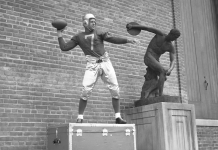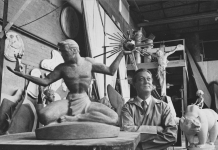
1930 Customs and rituals come and go, but one deserving of a revival is the celebratory act of dancing around a maypole — typically performed on May Day, May 1 — to usher in the month and its promise of clement weather.
Most historians agree that the maypole has its roots in either pagan fertility rituals or a demonstration of a wish for bountiful crops. Gradually, it lost those associations and simply became a joyous festivity welcoming late spring as celebrants weary of a long winter cavorted around a pole festooned with ribbons and flowers.
Here, circa 1930, children whirl around the maypole at the Merrill-Palmer Institute (now the Merrill Palmer Skillman Institute for Child & Family Development) on East Ferry in Midtown Detroit. The child-development center was founded by philanthropist Lizzie Pitts Merrill Palmer, who left a bequest after her 1916 death to fund it. She was married to Sen. Thomas Palmer, after whom Palmer Park was named after he donated the land to the city in 1893. The institute began in 1920 and has been part of Wayne State University since 1981.
There is another layer of history in this photo as well. In the rear is the former home of Charles Lang Freer (1854-1919), a wealthy industrialist, collector of American and Asian art, and connoisseur of Asian and Middle Eastern pottery and porcelain. Merrill-Palmer moved into his former residence in 1923. The shingle-style dwelling was completed in 1892 by Philadelphia architect Wilson Eyre Jr., who also designed the Detroit Club at Cass and Fort in downtown Detroit. Freer’s collection is displayed at the Freer Gallery of Art, part of the Smithsonian Institution in Washington, D.C. The nonprofit organization Freer House keeps Charles Freer’s legacy alive by holding tours and hosting speakers.
This story is from the May 2022 issue of ∫⁄¡œÕ¯ Detroit.
|
| Ã˝ |
|








